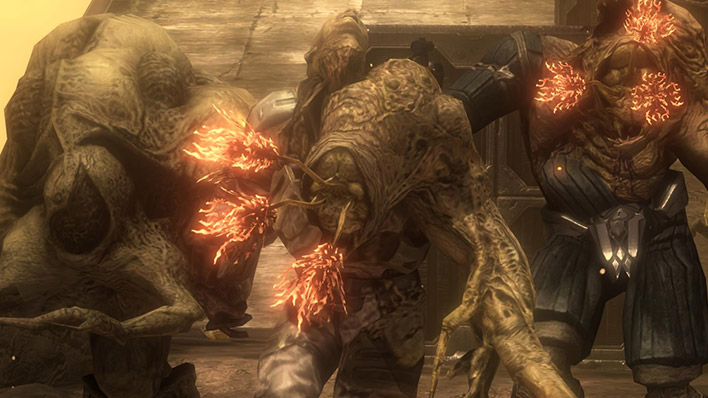

As this process occurs, bodies take on the appearance and smell of decay. Once infected, the super cell begins to consume and convert sections of the host body, creating growths and new appendages of new super cell. Even if the infection form is removed, the injection of FSC into the generated wounds results in those wounds becoming spore-filled blisters, and the host cannot be saved from infection. Some hosts may be attacked and infected by multiple pod infectors. This process can be performed on living or recently-deceased hosts, though often results in the "death" of a living host prior to their re-animation once the FSC takes hold. Depending on the host in question, the pod infector will dislodge the host's bones and organs to make room for itself, resulting in extreme disfiguration such as dislocating the host's jaw or, in the case of infected Sangheili, completely snapping the neck. Typically, the pod infector makes its home within the chest cavity of the host life form, though depending on circumstance this is not always the case. When conventionally infected by a pod infector, the infector latches onto the host and dig into the host's flesh with a razor-sharp barb-like appendage, injecting the FSC and proceeding to burrow themselves within the host. However, infection by spore inhalation or infection form is extremely quick, with a host succumbing often in as little as a few seconds. Given the combat forms' preference for melee combat, this makes even non-fatal strikes a death sentence, though such infections may progress slowly. Īs Flood forms, including the combat form, naturally produce the Flood Super Cell (FSC), even being in contact with one can result in infection for an unprotected potential host. Some Flood structures such as the " launcher" specialize in firing clouds of spores at uninfected forces, causing them to succumb to the infection without any kind of infection form involved. By this point, the Flood presence makes up the majority of the terrain in the area, making contact with the Flood Super Cell and the naturally-generated spores an inevitability. In more advanced stages of infection, the need for specific infection forms is decreased as the Flood-infected area converts to a Blightland or Flood hive. Flood outbreaks can often be caused by spores or other microbiological vectors entering the host body, or by contact with other forms that include Flood Seeders or Infesters. Pathology Infection and creation Ĭombat forms are typically created when a pod infector is successfully able to enter a host's body, though this is not the only vector by which hosts can be infected.


 0 kommentar(er)
0 kommentar(er)
